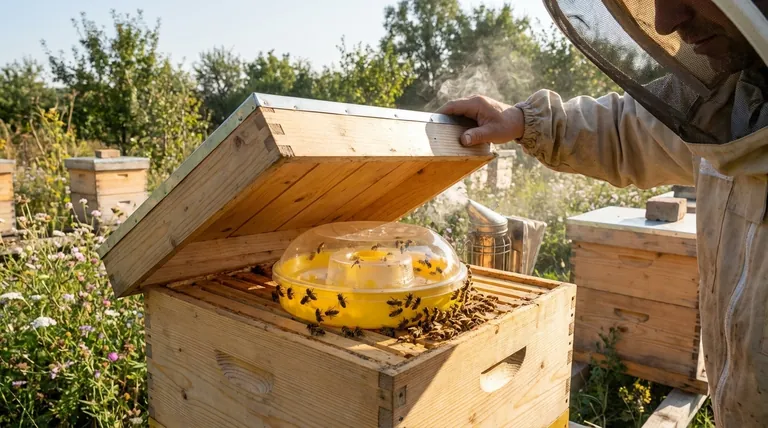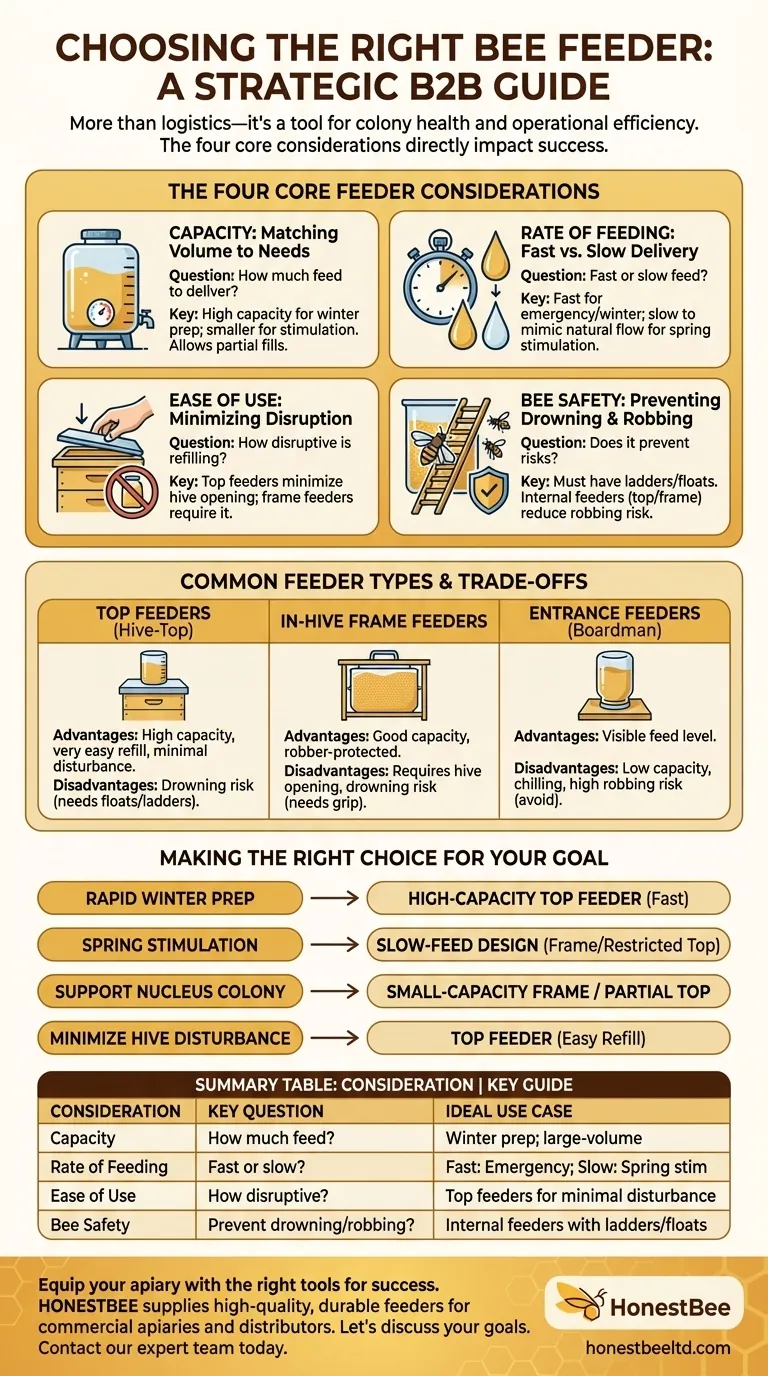Choosing the right bee feeder is about more than just holding sugar water; it’s about effectively managing your colony's health and resources. The most critical considerations are the feeder's capacity, the rate at which it delivers feed, its ease of use for the beekeeper, and its safety for the bees. These factors directly influence your success in tasks like preparing a hive for winter or stimulating growth in the spring.
Your choice of feeder is not just a logistical decision—it is a strategic tool that directly impacts bee behavior, colony health, and your own efficiency. The best feeder is always the one that best matches your specific goal for feeding at that moment in time.

The Four Core Feeder Considerations
A feeder's design dictates how and when bees access food. Understanding the four primary attributes will allow you to select the right tool for the job, whether you are managing a single backyard hive or a large apiary.
Capacity: Matching Volume to Your Colony's Needs
The amount of feed a feeder can hold is its most obvious feature. A large capacity is essential when you need to deliver a large volume of feed quickly, such as building up honey stores before winter.
For smaller colonies, like a nucleus hive, or for stimulative feeding where you only offer a small amount, a smaller feeder is sufficient. Remember, you can always partially fill a large-capacity feeder if needed.
Rate of Feeding: Fast vs. Slow Delivery
The rate of feeding is determined by how much surface area of syrup the bees can access at once. A fast feed, where bees can quickly consume large quantities, is ideal for emergency feeding or rapid winter preparation.
A slow feed, which limits access, mimics a natural nectar flow. This is used for stimulating the queen to lay in the spring without overwhelming the brood nest with stored syrup.
Ease of Use: Minimizing Hive Disruption
Some feeders are significantly easier to manage than others. A feeder that is easy to refill and clean saves you time and, more importantly, reduces the frequency and duration of hive inspections.
Top feeders, for example, are often recommended because they can be refilled with minimal disturbance to the colony. In contrast, frame feeders require you to fully open the hive for every refill.
Bee Safety: Preventing Drowning and Robbing
A poorly designed feeder can be dangerous. The most significant risk is bee drowning. Look for designs that include ladders, floats, or screened-off areas that allow bees to access the syrup without falling in.
The second risk is robbing, where bees from stronger, nearby hives are attracted to the feed and attack the colony. Feeders that are internal to the hive, like top feeders and frame feeders, dramatically reduce this risk compared to external entrance feeders.
Understanding the Trade-offs: Common Feeder Types
No single feeder is perfect for every situation. Each design comes with a distinct set of advantages and disadvantages that you must weigh against your goals.
Top Feeders (Hive-Top Feeders)
These sit directly on top of the uppermost hive body, under the outer cover. They offer very high capacity and are exceptionally easy to refill without disturbing the bees.
Their primary drawback is the risk of bee drowning if they lack adequate floats or ladders. It's crucial to ensure your bees have safe access.
In-Hive Frame Feeders
These feeders are shaped like a standard frame and hang inside the hive body, replacing one or two frames. They offer good capacity and are well-protected from robbers.
However, refilling them requires opening the hive completely. Like top feeders, they pose a significant drowning risk unless equipped with floats or textured interior walls for grip.
Entrance Feeders (Boardman Feeders)
These small feeders fit into the hive entrance, typically using an inverted jar. Their main advantage is that you can see the feed level from outside the hive.
Unfortunately, their capacity is very low, they can chill the feed in cool weather, and they are notorious for inciting robbing. Most experienced beekeepers avoid them for anything other than providing water.
Making the Right Choice for Your Goal
Select your feeder based on a clear objective. This ensures your feeding strategy supports the colony instead of creating new problems.
- If your primary focus is rapid winter preparation: A high-capacity top feeder is your most efficient tool for delivering large volumes of syrup quickly.
- If your primary focus is stimulating spring brood growth: A slow-feed design, such as an in-hive frame feeder or a top feeder with restricted access, effectively mimics a natural nectar flow.
- If your primary focus is supporting a small nucleus colony: A small-capacity frame feeder or a partially filled top feeder gives you control without overwhelming the colony or risking robbing.
- If your primary focus is minimizing hive disturbance: A top feeder is the clear winner, as it allows for fast refills with almost no disruption to the bees.
Matching your feeder to your beekeeping goal turns a simple task into a powerful management strategy.
Summary Table:
| Consideration | Key Question | Ideal Use Case |
|---|---|---|
| Capacity | How much feed do I need to deliver? | Winter preparation; large-volume feeding |
| Rate of Feeding | Do I need a fast or slow feed? | Fast: Emergency feeding; Slow: Spring stimulation |
| Ease of Use | How much will refilling disrupt the hive? | Top feeders for minimal disturbance |
| Bee Safety | Does the design prevent drowning and robbing? | Internal feeders (top/frame) with floats or ladders |
Equip your apiary with the right tools for success.
Choosing the correct feeder is a critical step in effective hive management. At HONESTBEE, we supply commercial apiaries and beekeeping equipment distributors with high-quality, durable feeders designed with bee safety and beekeeper efficiency in mind. Our wholesale-focused operations ensure you get the reliable equipment you need to support colony health through every season.
Let's discuss your specific feeding goals and find the perfect solution for your operation. Contact our expert team today to get started.
Visual Guide

Related Products
- HONESTBEE Round Hive Top Bee Feeder for Syrup
- Boardman Entrance Bee Feeder Durable Galvanized Steel and Wood Construction for Beekeeping
- HONESTBEE Entrance Bee Feeder Professional Hive Nutrition Solution for Beekeeping
- Professional Hive Front Entrance Bee Feeder
- Classic Boardman Entrance Bee Feeder Hive Front Feeding Solution
People Also Ask
- What is the correct method for preparing sugar syrup for bees? Ensure Safe, Non-Toxic Feeding for Your Hives
- How do you set up and use a top feeder for bees? A Step-by-Step Guide for Safe Feeding
- What safety features are included in top feeders? A Guide to Drowning Prevention and Hive Safety
- How should syrup for bees be prepared? Master the Ratio for a Thriving Hive
- What features make top feeders a reliable choice for beekeepers? A Guide to Safe, Efficient Hive Nutrition



















